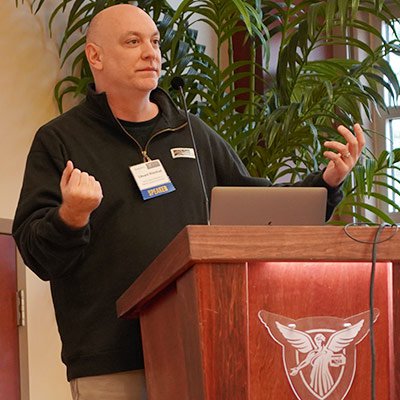Prepping for the future at NANOG U
Ten insights from Eddy Winstead's talk on DNS.
Brandi Herrera
- December 23, 2019
- Roundups

Among the brightest minds in our community, Eddy Winstead and nine other Internet technology experts recently took to the classroom during our first-ever NANOG U tour at the University of Illinois Urbana-Champaign, Purdue, and Ball State.
From DDoS attacks, to mitigation, network optimization, and more, NANOG U presented three days of talks on some of the most current developments and challenges the industry faces today.
Eddy, a Senior Sales Engineer at Internet Systems Consortium (ISC), was first introduced to NANOG back in ‘96 via our mailing list, and has been an active member of the NANOG community ever since — including serving on the NANOG Outreach Committee. As an engineer who was given his first opportunity in the field when he was just a teenager, Eddy is familiar with the unique experiences a program like NANOG U can offer students.
“I was very fortunate to have received an internship early on (in high school!), which turned out to be my first introduction to UNIX,” he said. “This directly led to my entire career path in Internet Engineering, with a specific focus on DNS. The internship started with some folks coming out to our school, and talking to us about their professional lives. I'm grateful to now be able to do the same thing many years later via NANOG U.”
Eddy shared a number of valuable insights during his talk on DNS that we've been mulling over since the tour wrapped, and he was kind enough to share his own top ten with us:
1.
The DNS is a critical part of the Internet, but one that is often overlooked.
2.
To most users, if the DNS is broken, it means the Internet is down. Internet engineers know this isn't the case, but the user knows this is the case.
3.
The original DNS protocol is over 35 years old. To say it has scaled amazingly well is a vast understatement.
4.
There have been many changes and improvements to the DNS protocol over the years. If DNS — or any other Internet related protocol — interests you, all of the documentation is there for you to reference in the RFCs.
5.
DNS theory is fairly straightforward — there are questions, and there are responses. But DNS in practice in 2019 — with its many servers and functions, load-balancers and firewalls — is not straightforward at all!
6.
I always attempt to get students to ponder their DNS queries. Most users never think of this. When I ask a DNS question, where does it go, and who is answering it?
7.
There are many privacy and security concerns around the DNS. Who sees my queries, and why?
8.
What roles do TCP and UDP play in the delivery of DNS services? These types of questions really get the students engaged; you can actually see their brains churning!
9.
If you're interested in learning more about DNS, one way to do that is by installing DNS software on your laptop and running it yourself. Doing so is sure to cause occasional problems, which are also valuable learning opportunities.
10.
There are many career paths available in tech, including ones being developed now that we don't even know about. And they aren't only about configurations — there's also a large human component to navigate. This provides for opportunities that may take you away from working strictly at the command line, but that's absolutely okay! While you may find yourself somewhere that doesn't feel like a great fit at that moment, what you’re learning there is preparation for things to come.